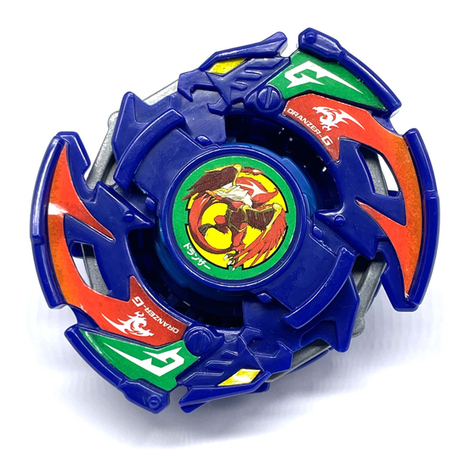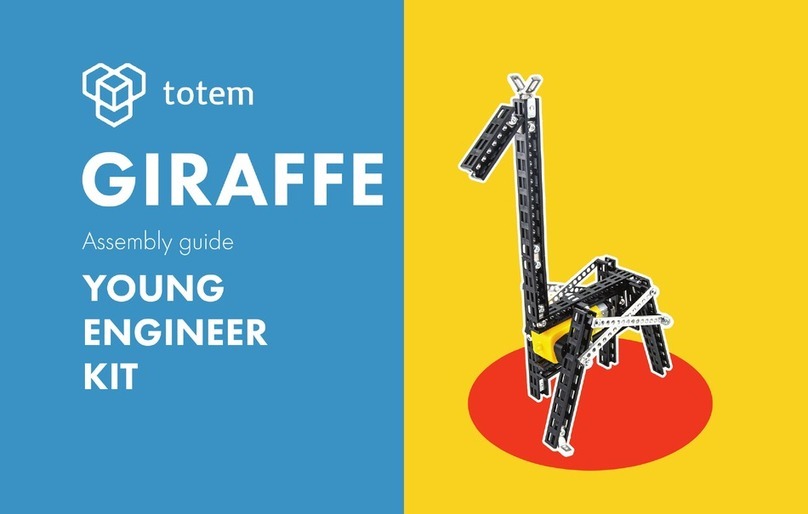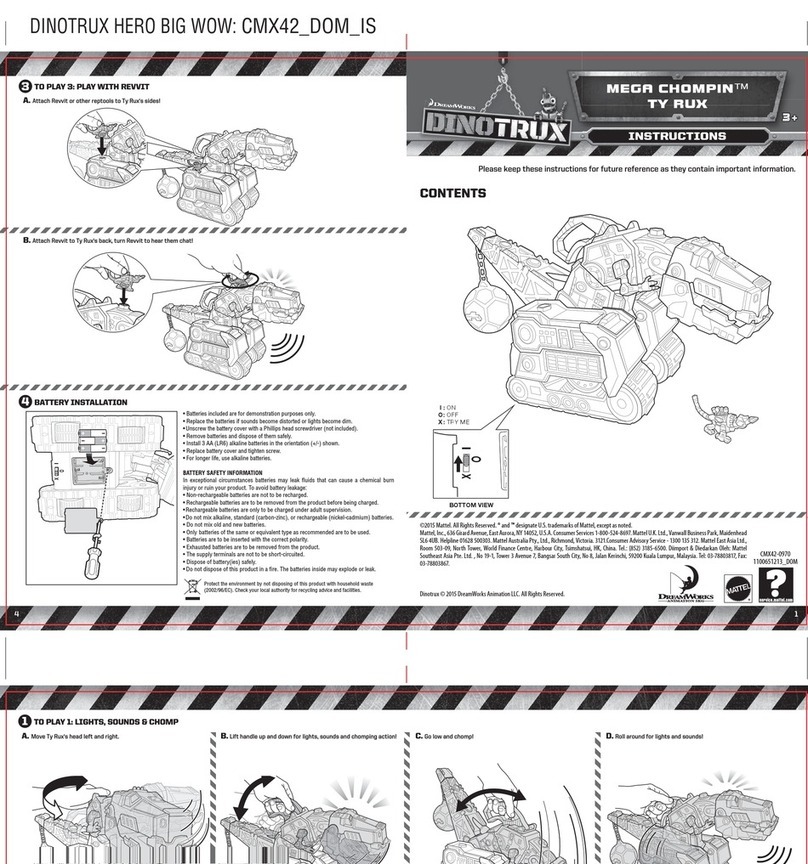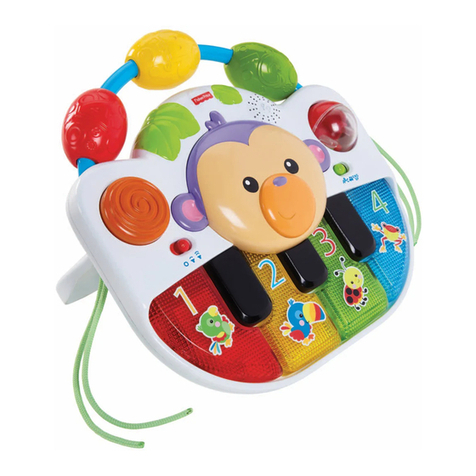Sport Flyers Sport Flyers Rhythm 3D EP User manual

Page 1
FEATURES
ASSEMBLY INSTRUCTIONS
Check out our website for more information about other exciting Sport Flyers products!
WWW.HOBBYPEOPLE.NET
Wing Span Top and Bottom: 30 Inches (762mm) lWing Area: 350 Square Inches (22.6dm2) lLength: 33 Inches (838mm)
Weight RTF: 13 Ounces (369gr) lWing Loading: 5.5 Ounces/Square Foot (156gr/dm2) lFunctions: Elevator, Rudder, Throttle and Ailerons
Radio Required: 4-Channel or More w/3 Micro Servos and Micro Rx lMotor Required: KMS 2208/26 Brushless Outrunner Motor
ESC Required: KMS 18 Amp Brushless lBattery Required: Impulse Power 3 Cell 900mAH LiPO
lFactory-Cut and -Printed Foam Parts
lFull-Shape Fuselage with Foam Stiffeners and Sheet-Foam Elliptical Wings
lCarbon Fiber Stiffeners for Great Strength
lCarbon Fiber Landing Gear with Lightweight Wheels and Wheel Covers
lAccepts a Wide Range of Outrunner Brushless Motors and Micro Radio Equipment
lDifferent Color Scheme on Top and Bottom Presents Well During Maneuvers
lGreat Flying Characteristics
lIncludes all Necessary Hardware
lFast and Easy Assembly - 60 High-Resolution Digital Photos to Guide You
Made in China Kit Product Number 160532
The Sport Flyers Rhythm 3D EP Biplane is sold exclusively
in the USA by Hobby People
18480 Bandilier Circle, Fountain Valley, CA 92708
Copyright © 2006, Hobby People - All Rights Reserved
Version 1.0 March 2007
SPECIFICATIONS
Celebrating 35 years serving modelers the world over, Hobby People wanted to bring their customers a top-performing 3D foamy
that was light, versatile, fun, and affordable. A nice model to celebrate 35 years of making planes for the real champions, those who
y for fun!
Working with aeronautical engineers and modelers from around the world, Hobby People presents the Rhythm. The Rhythm is as
neutral and as uncoupled as we could ever hope for in a foamie bipe. Almost zero roll-coupling, and almost zero compensation
needed for inverted and knife edge ight, the Rhythm is amazingly smooth throughout the ight envelope. You'll notice amazing
rudder response, yet with properly set up control throws and exponential, the Rhythm is smooth and "honest". Indeed, it is fun and
the Sport Flyer is going to love ying the Rhythm.

Page 2
Thank you for purchasing the Sport Flyers Rhythm 3D EP Biplane. We're condent that the quality of your new airplane
meets and even exceeds your expectations. Before beginning assembly of your new airplane, please carefully read through
these assembly instructions in their entirety. Doing so will ensure your success the rst time around!
These assembly instructions are designed to guide you through the entire assembly process of your new airplane in the least amount
of time possible. Along the way you'll learn how to properly assemble your new airplane and also learn tips that will help you in the
future. We have listed some of our recommendations below. Please read through them before beginning assembly.
lPlease read through each step before beginning assembly. You
should nd the layout very complete and straightforward. Our goal
is to guide you through assembly without any of the headaches
and hassles that you might expect.
lThere are check boxes next to each procedure. After you
complete a procedure, check off the box. This will help prevent
you from losing your place.
lCover your work table with brown paper or a soft cloth, both to
protect the table and to protect the parts.
lKeep a couple of small bowls or jars handy to put the small parts
in after you open the accessory bags.
l We're all excited to get a new airplane in the air, but take your
time. This will ensure you build a straight, strong and great ying
airplane.
lIf you come across this symbol *, it means that this is an
important point or an assembly hint.
INTRODUCTION
TABLE OF CONTENTS
This R/C airplane is not a toy! If misused or abused, it can cause serious bodily injury and/or damage to property. Fly only in open
areas and preferably at a dedicated R/C ying site. We suggest having a qualied instructor carefully inspect your airplane before
its rst ight. Please carefully read and follow all instructions included with this airplane, your radio control system and any other
components purchased separately.
SAFETY WARNING
INTRODUCTION..................................................................................................... 2
SAFETY WARNING ................................................................................................ 2
OUR GUARANTEE ................................................................................................. 2
IMPORTANT INFORMATION ABOUT FOAM - PLEASE READ ............................. 3
OUR RECOMMENDATIONS .................................................................................. 3
LITHIUM POLYMER BATTERY WARNINGS - PLEASE READ.............................. 4
TOOLS AND SUPPLIES REQUIRED ..................................................................... 5
KIT CONTENTS ...................................................................................................... 5
MOTOR INSTALLATION ......................................................................................... 6
TIPS FROM THE PROS.......................................................................................... 6
STABILIZER INSTALLATION .................................................................................. 8
RUDDER AND AILERON HINGING........................................................................ 9
WING INSTALLATION............................................................................................11
CONTROL SYSTEMS INSTALLATION................................................................. 13
LANDING GEAR INSTALLATION ......................................................................... 17
FINAL ASSEMBLY................................................................................................. 18
BALANCE POINT AND CONTROL THROWS...................................................... 20
PRODUCT EVALUATION SHEET......................................................................... 23
CUSTOMER SERVICE INFORMATION
Hobby People will not disclose the information it collects to outside parties. Hobby People does not sell, trade, or rent your personal information to others . Your privacy is important to us.
IMPORTANT INFORMATION ABOUT YOUR EMAIL ADDRESS
Global Services
18480 Bandilier Circle
Fountain Valley, CA 92708
Phone: (714) 963-0329
Fax: (714) 964-6236
Email: service@globalhobby.net
Check out our support website at http://globalservices.globalhobby.com. There you will nd public message boards frequented by other Sport Flyers
product owners and the Sport Flyers technical support staff. This is a great place to get quick answers and advice on your new product.
To enable us to better serve your needs, please include your email address with any correspondence you send to us. Your email address will be added
to our Customer Service Database so you will automatically receive free updates and tech notices for your particular product. You will also receive
repair status updates (if applicable) and other important information about your product as it becomes available.

Page 3
Please read through this entire section very carefully. We have provided you with recommendations that,
if followed, will result in a great ying airplane. Failure to follow our recommendations may result in a poor
ying airplane.
OUR RECOMMENDATIONS
RECOMMENDED BRUSHLESS POWER SYSTEM
RECOMMENDED RADIO, RECEIVER AND SERVOS
lKMS KBM 31/21 Brushless Outrunner Motor
lKMS 18 Amp Brushless ESC
lAPC 10 x 3.8 Slow Flyer Propeller
lImpulse Power 2C 900mAH LiPO Battery
lProPeak Quattro LiPO DC Charger
HERE'S A LIST OF WHAT WE USED TO FINISH THE RHYTHM 3D EP BIPLANE SHOWN IN THESE INSTRUCTIONS
You will need to use a 4 or more channel transmitter with a 4 or more channel micro
receiver and 3 micro servos. Ideally, the transmitter should feature dual rates and
exponential for the ailerons, elevator and rudder. The receiver should be as light as
possible, preferably around 9 grams. The servos should be the lightest available,
yet still have an adequate amount of torque. We suggest using servos that weigh
no more than 5 grams and have a torque rating of no less than 10 ounces per square
inch. Cirrus CS101 or similar micro servos will work well.
lKMS Quantum 2208/26 Brushless O.R. Motor
lKMS 18 Amp Brushless ESC
lAPC 9 x 4.7 Slow Flyer Propeller
lImpulse Power 3C 900mAH LiPO Battery
lProPeak Quattro LiPO DC Charger
ALTERNATE BRUSHLESS POWER SYSTEM
The Rhythm 3D EP Biplane can be own using a variety of brushless direct drive Outrunner motors. The combination we recommend
here is lightweight, inexpensive and will provide ample power for 3D aerobatics.
QTY. 1 Hitec Optic 6 FM Transmitter
QTY. 1 443534 Cirrus MRX-4II FM Micro Receiver
QTY. 1 4462xx Cirrus Crystal for MRX-4II (xx is Channel #)
QTY. 1 108464 KMS Quantum 2208/26 Brushless O.R. Motor
QTY. 1 108228 KMS 18 Amp Brushless ESC
QTY. 3 440101 Cirrus CS101 Micro Servos
QTY. 1 608931 APC 9 x 4.7 Slow Flyer Propeller
QTY. 1 182233 Impulse Power 3C 900mAH LiPO Battery
QTY. 1 158370 ProPeak Quattro LiPO Charger
QTY. 1 158102 Xtra 2mm Gold Connector Set
QTY. 1 869020 Dubro Double-Sided Tape
QTY. 1 3M 3/4" Wide Clear Plastic Tape
The Rhythm 3D EP Biplane is constructed from sheet foam. You can use 5 minute epoxy or foam-friendly C/A for assembly. If you
use C/A, you MUST USE FOAM-FRIENDLY C/A AND AEROSOL C/A "KICKER." If you use C/A that is not foam-friendly and
non-aerosol "Kicker," these products will melt the foam and ruin the airplane.
If you use the Pacer Aerosol Zip-Kicker that is recommended, it is very important that you use it properly to prevent melting
the foam. Always spray a very light "mist" from no less than 12" (30cm) from the surfaces to be glued. After spraying the
surfaces, immediately wipe off any excess with a soft towel. If you spray too much on one area or leave it on too long, it
will melt the foam.
Do not use any harsh solvents, such as acetone, to clean the airframe. Harsh solvents will melt the foam. It is okay to use rubbing
alcohol. If you want to add more painted details to your airplane, use water-based acrylic paints and test on a scrap piece rst.
IMPORTANT INFORMATION ABOUT FOAM - PLEASE READ

Page 4
LITHIUM POLYMER BATTERY WARNINGS - PLEASE READ
WARNINGS AND SAFETY PRECAUTIONS FOR ALL BRANDS OF LITHIUM POLYMER BATTERIES
Please read and understand the warnings listed in this section. Make sure to read any and all warnings
included in the packaging with your battery, too. If used improperly, lithium polymer (LiPO) batteries can
be very dangerous, so please follow these warnings and suggestions at all times.
l Your LiPO battery may explode or catch re. Serious injury, loss of property, re and death can result from misuse.
l All instructions, warnings and cautions must be followed at all times. Failure to do so can lead to serious injury or re.
lDo NOT use your LiPO battery before reading and understanding all directions and warnings.
lDo NOT overcharge your LiPO battery. Maximum voltage for each LiPO battery must be followed.
lDo NOT over-discharge your LiPO battery. NEVER discharge below minimum volts.
lDo NOT discharge your LiPO battery at a rate greater than the maximum continuous discharge.
lDo NOT use or charge your LiPO battery if it is hot.
l ONLY use a charger made specically for LiPO batteries.
lDo NOT charge your LiPO battery at a rate higher than 1C. Example: if the your LiPO battery’s rating is 340mAH, then the charger’s
charge rate must be set at 340mAH or less.
lDo NOT leave your LiPO battery in direct sunlight or in a hot car or storage area.
lDo NOT get your LiPO battery wet or expose to moisture.
lDo NOT short-circuit your LiPO battery.
l ONLY discharge and charge your LiPO battery outdoors or in a resafe container.
lDo NOT charge your LiPO battery with reverse polarity.
lDo NOT leave your LiPO battery connected when not in use.
lDo NOT operate or charge your LiPO battery unattended.
lDo NOT solder to your LiPO battery directly and do not get your LiPO battery hot in any way.
CHARGING PRECAUTIONS FOR ALL BRANDS OF LITHIUM POLYMER BATTERIES
lDo NOT use your LiPO battery if you do not understand the warnings and proper use of your LiPO battery.
lAlways let your LiPO battery cool and "rest" between uses and charging.
lTo avoid over-discharging your LiPO battery, only use a speed control that is made for LiPO batteries.
l We recommend the use of a resafe container when charging or storing your LiPO battery.
lDo NOT charge your LiPO battery inside your car or inside your house.
lInspect your LiPO battery before each use for swelling or other malformation. If a cell has ballooned, your LiPO battery MUST
be discarded.
l Set your charger to 1C (charge at 1/2C or less for the rst 5 cycles).
l Check polarity rst, then connect your LiPO battery to your charger.
lIn use, do not over-discharge your LiPO battery or exceed maximum discharge.
lWhen handling your LiPO battery, remember not to poke, bend or damage the cells. The cell's outer casing is soft and can
be damaged.
lRemember, your LiPO battery must never exceed 160 degrees Fahrenheit for any reason.

Page 5
oPencil
oT-Pins
o Builder's Triangle
o220 Grit Sandpaper with Sanding Block
oMasking Tape
oPaper Towels
qWaxed Paper
oRubbing Alcohol
oEpoxy Mixing Sticks
oEpoxy Mixing Cups
oSoldering Iron
oSolder
oHeat-Shrink Tubing (Assorted Sizes)
oHeat Gun (for Heat-Shrink Tubing)
o5 Minute Epoxy
oFoam-Friendly Thin and Thick C/A
qAerosol Zip-Kicker
o# 0 and #1 Phillips Head Screwdrivers
o1.5mm Hex Wrench
oAdjustable Wrench
oWire Cutters
oZ-Bend Pliers
oNeedle Nose Pliers
oModeling Knife
oScissors
oElectric or Hand Drill
oAssorted Drill Bits
oStraight Edge Ruler
TOOLS AND SUPPLIES REQUIRED
KIT CONTENTS
Before you begin assembly, group the parts as we list them below. This will ensure that you have all of the parts before you begin
assembly and it will also help you become familiar with each part.
IF YOU FIND ANY PARTS MISSING OR DAMAGED, PLEASE CONTACT US DIRECTLY,
USING THE CUSTOMER SERVICE INFORMATION ON PAGE 2.
o(A) Fuselage - 1
o(B) Bottom Wing with Ailerons - 1
o(C) Top Wing with Ailerons - 1
o(D) Horizontal Stabilizer with Elevator - 1
o(E) Rudder - 1
o(F) Outer Wing Struts - 2
o(G) Wing Fences - 4
o(H) Landing Gear Struts - 2
o(I) Tail Wheel Assembly - 1
o(J) Large Doublers with Round Hole - 4
o(K) Small Doublers with Round Hole - 4
o(L) Wheel Covers - 2
o(M) Main Gear Wheels - 2
q(N) Carbon Fiber Rods - 6
o(O) Large Doublers with Elongated Hole - 4
o(P) Plywood Pushrod Supports - 4
o(Q) Small Doublers with Elongated Hole - 16
o(R) Plain Wires - 2
q(S) Control Horn Backplates - 4
q(T) Control Horns - 4
q(U) Carbon Fiber Strips - 3
q(V) Heat-Shrink Tubing - 1
q(W) Wood Screws - 3
q(X) Plywood Motor Mount - 1
q(Y) Hook and Loop Material - 1
A
B
C
E
F
G
I
JK
H
M
L
N
OP
Q
S
R
T
V
U
W
X
Y
D

Page 6
TIPS FROM THE PROS
MOTOR INSTALLATION
YOU'LL NEED THE FOLLOWING PARTS FROM THE KIT:
YOU'LL NEED THE FOLLOWING TOOLS AND SUPPLIES:
oFoam-Friendly Thin C/A
o# 1 Phillips Head Screwdriver
o220 Grit Sandpaper with Sanding Block
o(A) Fuselage - 1
o(W) Wood Screws - 3
o(X) Plywood Motor Mount - 1
IMPORTANT This section shows mounting two different types of brushless motors. Step 1A shows the installation of the KMS 2208/26
brushless outrunner motor. Step 1B shows the installation of the KMS 31/21 brushless outrunner motor. Follow the step that matches
the motor type that you're using.
STEP 1A: INSTALLING THE MOTOR - KMS RADIAL MOUNTED BRUSHLESS OUTRUNNER OR SIMILAR
PRO TIP The KMS brushless motor features a rear-mounted propeller adapter and an aluminum radial motor mount that's
compatible with the predrilled holes in the rewall.
oInstall the propeller adapter onto your motor, using the screws provided
with your motor.
l Do not throw away any of the extra pieces of carbon ber strips and carbon ber rods until after you're done with assembly.
l Make sure to test-t the parts together before applying glue. This will ensure that the parts t properly before gluing them together.
lWhen gluing anything that has a smooth surface, like the plastic doublers, roughen the gluing surfaces lightly with 220 grit sandpaper.
This will allow the glue to stick better.
lWe do not suggest storing your airplane in an extremely hot environment (like the back of your car in direct sunlight) for any
length of time. The extreme heat could damage the foam parts and possibly damage the fragile components of the radio control
system or battery.
l After ying the airplane, you may want to add right and/or down thrust to the motor. You can do this by adding thin washers between
the motor mount and the rewall.
lTo make aligning and gluing the top wing into place easier, glue it into place with the airplane upside down on your work table.
l If the control horns still move slightly with the backplates installed, apply some glue to the control horns to lock them rmly
into place.
lWhen assembling the pushrods, apply a few drops of thin C/A to the end of the pushrods after shrinking the heat-shrink material.
The thin C/A will "wick" into the joint, giving it an extra measure of security.
lWhen using your heat gun near the foam surfaces, be careful not to melt the foam.
lWhen installing the landing gear struts, make sure that both axles are even with each other (the same distance from the bottom of
the wing) or else the airplane won't sit level on the ground. Make sure that the axles are straight, too, or else the airplane won't roll
straight on the ground.
l When installing your motor onto the plywood motor mount, use pan head screws, so that when tightened, they're ush with the back
of the motor mount. This will prevent the heads of the screws from interfering with the installation of the motor assembly onto
the rewall.

Page 7
o Install the motor assembly onto the rewall, using the three wood screws
provided.
PRO TIP After ying the airplane, you may want to add right and/or down
thrust to the motor. You can do this by adding thin washers between the
motor mount and the rewall. Please see page 20 for more information.
STEP 1B: INSTALLING THE MOTOR - KMS BRUSHLESS OUTRUNNER OR SIMILAR
oInstall the plywood motor mount onto your motor, using the screws
provided with your motor.
IMPORTANT Use pan head screws, so that when tightened, they're
ush with the back of the motor mount. This will prevent the heads of
the screws from interfering with the installation of the motor assembly
onto the rewall.
o Install the motor assembly onto the rewall, using the three wood screws
provided.
PRO TIP After ying the airplane, you may want to add right and/or down
thrust to the motor. You can do this by adding thin washers between the
motor mount and the rewall. Please see page 20 for more information.
oInstall the aluminum motor mount (included with our motor) onto your
motor, using the screws provided with your motor.
oApply a couple of drops of foam-friendly thin C/Ainto the three corresponding
motor mount screw holes in the rewall and allow the C/A to fully cure. The
C/A will harden the surrounding plywood, making it stronger.
IMPORTANT One motor mount tab is mounted in the top center hole
in the rewall (A).
A
oApply a couple of drops of foam-friendly thin C/Ainto the three corresponding
motor mount screw holes in the rewall and allow the C/A to fully cure. The
C/A will harden the surrounding plywood, making it stronger.
IMPORTANT One motor mount tab is mounted in the top center hole
in the rewall (A).
A

Page 8
STABILIZER INSTALLATION
YOU'LL NEED THE FOLLOWING PARTS FROM THE KIT:
YOU'LL NEED THE FOLLOWING TOOLS AND SUPPLIES:
o5 Minute Epoxy
oFoam-Friendly Thick C/A
qAerosol Zip-Kicker
qModeling Knife
qRuler
q Builder's Triangle
o220 Grit Sandpaper with Sanding Block
oMasking Tape
oWaxed Paper
oPaper Towels
oRubbing Alcohol
oEpoxy Mixing Sticks
oEpoxy Mixing Cups
o3M 3/4" Clear Plastic Tape
o(D) Horizontal Stabilizer with Elevator - 1 o(U) Carbon Fiber Strip - 1
STEP 1: INSTALLING THE CARBON FIBER SUPPORT STRIPS
oSand a 45º bevel into the bottom leading edge of the elevator.
*The bottom has the light blue color scheme.
o Cut a piece of carbon ber strip to a length of 8-1/2" (216mm), then glue it
to the beveled leading edge of the elevator, using 5 minute epoxy. Remove
any excess epoxy using a paper towel and rubbing alcohol, and use pieces
of masking tape to hold the carbon ber strip in place.
IMPORTANT Make sure that the elevator is at and that the leading
edge is straight while the glue cures.
o Cut a piece of carbon ber strip to a length of 5" (127mm) and glue it
to the bottom of the stabilizer, making sure that it's even with the beveled
leading edge and centered.
o Cut a piece of carbon ber strip to a length of 8-1/2" (216mm) and glue
it to the trailing edge of the stabilizer, making sure that the stabilizer is at
while the glue cures.
q Sand the excess ush with the ends of the stabilizer.
STEP 2: INSTALLING THE STABILIZER
oSlide the elevator into the stabilizer mounting slot, making sure that the
top of the elevator is toward the top of the fuselage.
IMPORTANT You must slide the elevator into place before installing
the stabilizer. If you don't, it will be impossible to install the elevator after
the stabilizer is glued in place.

Page 9
oDraw a centerline mark on the trailing edge of the stabilizer.
oSlide the stabilizer into the fuselage and align it, using the notch in the
leading edge and the centerline mark that you drew as a reference.
o When satised with the alignment, glue the stabilizer to the fuselage, using
foam-friendly thick C/A.
IMPORTANT Make sure to apply a bead of glue to all four joints and
use a builder's triangle to ensure that the stabilizer is aligned 90º to
the fuselage side.
STEP 3: HINGING THE ELEVATOR
oWhile holding the elevator tight against the stabilizer, apply a strip of clear
plastic tape (not included) to the top of the hinge line on both sides of the
elevator.
o Turn the fuselage over and deect the elevator up approximately 45º.
While holding the elevator up at a 45º angle, apply a strip of clear plastic tape
(not included) to the bottom of the hinge line on both sides of the elevator.
oPush the tape gently down into the hinge line, then pivot the elevator up
and down several times to ensure free hinge movement in both directions.
RUDDER AND AILERON HINGING
YOU'LL NEED THE FOLLOWING PARTS FROM THE KIT:
YOU'LL NEED THE FOLLOWING TOOLS AND SUPPLIES:
o5 Minute Epoxy
oModeling Knife
o220 Grit Sandpaper with Sanding Block
oMasking Tape
oWaxed Paper
oPaper Towels
oRubbing Alcohol
oEpoxy Mixing Sticks
oEpoxy Mixing Cups
o3M 3/4" Clear Plastic Tape
o(B) Bottom Wing with Ailerons - 1
o(C) Top Wing with Ailerons - 1
IMPORTANT Before gluing the stabilizer into place in the next procedure, make sure that the stabilizer is aligned 90º to the straight
portion of the fuselage side below the stabilizer. Use a builder's triangle to check this. This will ensure that the stabilizer is level.
o(E) Rudder - 1
o(U) Carbon Fiber Strips - 2

Page 10
oSand a 45º bevel into the left side of the leading edge of the rudder.
STEP 1: HINGING THE RUDDER
oHinge the rudder to the back of the fuselage, using the same techniques
that you used to hinge the elevator to the stabilizer.
STEP 2: INSTALLING THE CARBON FIBER SUPPORT STRIPS
o Glue one carbon ber strip to the trailing edge of the top and bottom wings,
using the same techniques that you used to glue the carbon ber strips to
the elevator and stabilizer.
IMPORTANT Make sure that both wings are at while the glue cures.
oSand a 45º bevel into the bottom of the leading edge of the two bottom
wing ailerons.
IMPORTANT The bottom wing ailerons have one precut slot in each aileron for the control horns. The top wing ailerons don't
have any precut slots. Double-check that you're working with the bottom wing ailerons.
STEP 3: HINGING THE BOTTOM WING AILERONS
o Cut two carbon ber strips to a length of 26-1/4" (667mm).
oHinge the ailerons to the bottom wing, using the same techniques that
you used to hinge the rudder and the elevator.
IMPORTANT Again, make sure that you're hinging the ailerons with the
precut slot to the bottom wing.

Page 11
oSand a 45º bevel into the bottom of the leading edge of the two top wing
ailerons, then hinge the ailerons to the top wing, using the same techniques
that you used to hinge the ailerons to the bottom wing.
STEP 4: HINGING THE TOP WING AILERONS
WING INSTALLATION
YOU'LL NEED THE FOLLOWING PARTS FROM THE KIT:
YOU'LL NEED THE FOLLOWING TOOLS AND SUPPLIES:
oFoam-Friendly Thick C/A
qAerosol Zip-Kicker
qWire Cutters
qModeling Knife
qStraight Edge Ruler
qPencil
o220 Grit Sandpaper with Sanding Block
o(F) Outer Wing Struts - 2
q(N) Carbon Fiber Rods - 4
q(O) Large Doublers with Elongated Hole - 4
q(Q) Small Doublers with Elongated Hole - 16
oGlue the bottom wing to the fuselage, making sure that the slots in the
wing are pushed rmly over the mounting tabs on the fuselage.
STEP 1: INSTALLING THE BOTTOM WING
oGlue two small doublers to the top of each half of the wing, making sure
that the elongated hole in each doubler is centered over the precut holes in
the wing.
IMPORTANT The holes in the doublers are elongated. Make sure
that when you glue the doublers into place that the hole is parallel to the
trailing edge.
STEP 2: INSTALLING THE OUTER WING STRUTS
oGlue one large doubler to each side of both outer wing struts, making
sure that the elongated hole in each doubler is centered over the precut hole
in the struts.
IMPORTANT The holes in the doublers are elongated. Make sure that
when you glue the doublers into place the hole is positioned vertically.

Page 12
STEP 3: INSTALLING THE TOP WING
oGlue two small doublers to the bottom of each half of the wing, making
sure that the elongated hole in each doubler is centered over the precut holes
in the wing (A).
IMPORTANT The holes in the doublers are elongated. Make sure
that when you glue the doublers into place that the hole is parallel to the
trailing edge.
oGlue the top wing to the center wing mount and the outer wing struts,
making sure that the wing is perfectly at while the glue cures.
PRO TIP To make aligning and gluing the top wing into place easier, glue
it into place with the airplane upside down on your work table.
oGlue the two outer wing struts to the top of the wing, making sure that the
back edge of each strut is even with the hinge line. Use a builder's triangle
to make sure that the wing struts are perpendicular to the wing.
IMPORTANT Note the direction the wing struts are mounted. The
short vertical cut at the base of each wing strut should be toward the
trailing edge (A).
STEP 4: INSTALLING THE CARBON FIBER SUPPORT RODS
o Cut two pieces of carbon ber rod to a length of 14-3/4" (375mm).
q Push the end of one length of carbon ber rod down through the outer hole
in the top wing (A) and slide it through the hole in the outer wing strut (B).
oPush the end of the carbon fiber rod through the inner hole in the
bottom wing (A).
oRepeat the previous procedures to slide the second length of carbon
fiber rod through the wings.
A
A
A
A
B
A

Page 13
oGlue the two carbon fiber rods to only the bottom of the bottom wing,
using two small doublers.
qOnce the glue cures, cut the carbon fiber rods off flush with the
surface of the wing.
oWith the bottom wing perfectly flat, glue the two carbon fiber rods to
the top of the top wing, using two small doublers, then cut the carbon
fiber rods off flush with the surface of the wing.
IMPORTANT Use a straight edge to ensure that the top wing is at.
oRepeat the previous procedures to install the two carbon fiber rods
through the other side of the wings.
qOnce the glue cures, double-check the alignment of the wings, then
glue the carbon fiber rods to the outer wing struts.
IMPORTANT Use a builder's triangle to ensure that the outer wing struts
are aligned 90º to the wings.
CONTROL SYSTEMS INSTALLATION
YOU'LL NEED THE FOLLOWING PARTS FROM THE KIT:
YOU'LL NEED THE FOLLOWING TOOLS AND SUPPLIES:
oFoam-Friendly Thin and Thick C/A
q# 0 Phillips Head Screwdriver
qWire Cutters
qZ-Bend Pliers
qNeedle Nose Pliers
qModeling Knife
qStraight Edge Ruler
qPencil
o220 Grit Sandpaper with Sanding Block
qHeat Gun
q(N) Carbon Fiber Rods - 2
o(P) Plywood Pushrod Supports - 4
q(R) Plain Wires - 2
q(S) Control Horn Backplates - 4
q(T) Control Horns - 4
q(V) Heat-Shrink Tubing - 1
STEP 1: INSTALLING THE ELEVATOR AND RUDDER SERVOS
oInstall the elevator and rudder servos into the servo mounting hole in the
right side of the fuselage. Use a dab of foam-friendly thick C/A to secure
them into place.
*Because the size of servos differs, you may need to cut the servo
mounting hole larger to t your particular servos.
IMPORTANT Roughen the servo mounting tabs with 220 grit sandpaper so that the glue will stick better.

Page 14
STEP 2: INSTALLING THE ELEVATOR CONTROL LINKAGE ASSEMBLY
IMPORTANT When installing the control horn backplate in the next procedure, make sure that the at portion of the backplate
is facing away from the elevator.
oCarefully cut the front of the control horn mounting base off (A), then
install the control horn onto the bottom of the elevator, using the backplate
provided. Make sure to push the backplate rmly onto the control horn. It
should click into position and hold the control horn tightly.
PRO TIP If the control horn still moves slightly with the backplate installed,
apply some glue to the control horn to lock it into place.
o Cut one piece of carbon ber rod to a length of 5" (127mm), then cut two
pieces of heat-shrink tubing to a length of 1-1/2" (38mm).
oCut two pieces of plain wire to a length of 1-1/2" (38mm), then make a
Z-Bend in one end of each piece of wire and a 1mm long 90º bend in the
other end of each piece of wire.
o Secure one piece of wire to one end of the carbon ber rod, using one
piece of heat-shrink material. The piece of wire should overlap the carbon
ber rod at least 1" (25mm). Heat the heat-shrink material with a heat gun
to shrink it into place.
PRO TIP For extra security, apply a few drops of foam-friendly thin C/A
to the end of the pushrod and allow it to "wick" into the joint.
oInstall the Z-Bend into the hole that is 3/8" (10mm) out from the center of
the servo arm.
oCenter the elevator servo, then attach the servo arm to the servo, making
sure that it's centered and pointing up toward the top of the fuselage.
o Slide two plywood pushrod supports over the end of the carbon ber
rod and temporarily push the plywood pushrod supports into the two upper
precut slots in the fuselage.
IMPORTANT Don't glue the plywood pushrod supports into place yet.
A

Page 15
o Slide the second piece of heat-shrink tubing over the carbon ber rod,
then install the Z-Bend in the second piece of wire into the middle hole in
the control horn.
oCenter both the elevator servo and the elevator, then slide the heat-shrink
tubing over the wire.
oDouble-check that both the elevator servo and the elevator are centered,
then use a heat-gun to shrink the heat-shrink tubing. Remember to apply a
few drops of foam-friendly thin C/A to the joint for extra security.
WARNING Be careful not to melt the foam with the heat gun.
oGlue the two plywood pushrod supports into the upper mounting slots in the fuselage side. Adjust the depth of the plywood pushrod
supports to keep the pushrod as straight as possible to prevent binding.
STEP 3: INSTALLING THE RUDDER CONTROL LINKAGE ASSEMBLY
oCarefully cut the front of the control horn mounting base off (A), then
install the control horn, using the same techniques that you used to install
the elevator control horn.
o Cut the remaining piece of carbon ber rod to a length of 18-1/2" (470mm). Cut two pieces of heat-shrink tubing to a length of
1-1/2" (38mm), then cut two pieces of plain wire to a length of 1-1/2" (38mm) and make a Z-Bend in one end of each piece of wire
and a 1mm long 90º bend in the other end of each piece of wire.
o Install one piece of wire to one end of the carbon ber rod, then install
the Z-Bend into the hole that is 3/8" (10mm) out from the center of the servo
arm.
oCenter the rudder servo, then attach the servo arm to the servo, making
sure that it's centered and pointing down toward the bottom of the fuselage.
oInstall the Z-Bend in the second piece of wire into the middle hole
in the rudder control horn. Make sure that both the rudder servo arm and
the rudder are centered, then install the wire onto the end of the carbon ber
rod, using the same techniques that you used previously.
IMPORTANT Don't forget to slide the remaining two plywood pushrod
supports into place before securing the carbon ber rod to the piece
of wire.
IMPORTANT The rudder control linkage assembly is assembled and installed using the same techniques that you used to
assemble and install the elevator control linkage assembly.
A

Page 16
STEP 5: INSTALLING THE AILERON CONTROL LINKAGE ASSEMBLY
IMPORTANT The aileron control linkage assembly is assembled and installed using the same techniques that you used to
assemble and install the elevator and rudder control linkage assemblies. Please note that the carbon ber rods, wire pieces and
pieces of heat-shrink tubing are different lengths, though.
STEP 4: INSTALLING THE AILERON SERVO
oInstall the aileron servo into the servo mounting hole in the bottom wing,
using a couple of dabs of foam-friendly thick C/A to secure it into place.
*Because the size of servos differs, you may need to cut the servo
mounting hole larger to t your particular servo.
IMPORTANT Remember to roughen the servo mounting tabs with 220
grit sandpaper so that the glue will stick better.
o Cut two pieces of carbon ber rod to a length of 2-1/2" (64mm), then cut
four pieces of heat-shrink tubing to a length of 1" (25mm).
oCut four pieces of plain wire to a length of 1" (25mm), then make a Z-Bend
in one end of each piece of wire and a 1mm long 90º bend in the other end
of each piece of wire.
oInstall the aileron control linkage assembly, using the same techniques
that you used to install the elevator and rudder control linkage assemblies.
Before attaching the pushrod assemblies to the control horns, double-check to
make sure that both the aileron servo arm and both ailerons are centered.
STEP 6: INSTALLING THE AILERON LINK ROD ASSEMBLIES
o Cut four pieces of carbon ber rod to a length of 2-1/2" (64mm).
q Glue one piece of carbon ber rod to the bottom of each aileron. Position
the carbon ber rods 5-1/2" (140mm) out from the inside edge of the ailerons
(measured at the trailing edge) and align them perpendicular to the aileron
hinge line. The end of each carbon ber rod should overhang the trailing
edge of the ailerons 1/2" (13mm), too.
o Cut two pieces of carbon ber rod to a length of 7-3/8" (187mm), then
cut four pieces of heat-shrink tubing to a length of 1" (25mm).
IMPORTANT Remember to carefully cut the front of the control horn
mounting base off of each control horn before installing them.

Page 17
oWorking with one side of the wings for now, use masking tape to hold
both the top and the bottom ailerons centered.
q Slide one piece of heat-shrink tubing over each carbon ber rod on the
ailerons, then slide the ends of the long piece of carbon ber rod into the
ends of the heat-shrink tubing.
q Shrink the tubing tightly to secure the carbon ber rod into position.
o Repeat the previous procedures to install the second carbon ber link rod to the other half of the wings.
LANDING GEAR INSTALLATION
YOU'LL NEED THE FOLLOWING PARTS FROM THE KIT:
YOU'LL NEED THE FOLLOWING TOOLS AND SUPPLIES:
oFoam-Friendly Thick C/A
qAerosol Zip-Kicker
qStraight Edge Ruler
o220 Grit Sandpaper with Sanding Block
q(H) Landing Gear Struts - 2
o(I) Tail Wheel Assembly - 1
q(J) Large Doublers with Round Hole - 4
q(K) Small Doublers with Round Hole - 4
q(L) Wheel Covers - 2
q(M) Main Gear Wheels - 2
STEP 1: INSTALLING THE LANDING GEAR STRUTS
oGlue two large doublers to the bottom of the bottom wing, making sure
that the hole in each doubler is centered over the precut holes in the wing.
oPush one landing gear strut up through the wing and slide a second large
doubler over the end of the landing gear strut.
oPush the end of the landing gear strut into the precut hole in the fuselage
side, then twist the landing gear strut so that the axle is straight.
q When satised with the alignment, glue the landing gear strut to the fuselage
side and to the doublers on both the top and the bottom of the wing.
IMPORTANT When you push the end of the landing gear strut up into the precut hole in the side of the fuselage in the next
procedure, you only want to push the end of the strut about 1/4" (6mm) into the hole. The wire axle should be approximately
1-3/4" (44mm) below the bottom of the wing for proper stance and ground clearance.

Page 18
oRepeat the previous procedures to align and install the second landing
gear strut.
IMPORTANT Make sure that both wire axles are even with each other
(the same distance from the bottom of the wing) or else the airplane won't
sit level on the ground.
STEP 2: INSTALLING THE WHEEL COVERS
oGlue one small doubler to each side of both wheel covers, making sure
that the hole in each doubler is centered over the precut hole in the wheel
covers.
oSlide one main gear wheel onto each axle, then roughen the outer portion of
each axle, using 220 grit sandpaper, so that the glue will stick to the metal.
qSlide one wheel cover onto each axle and up against the wheels. Align
the wheel covers, then glue them securely to the axles.
IMPORTANT Only glue the wheel covers from the outside. Don't get any glue between the wheel covers and the wheels.
STEP 3: INSTALLING THE TAIL WHEEL ASSEMBLY
oGlue the tail wheel assembly into the slot in the bottom of the fuselage.
FINAL ASSEMBLY
YOU'LL NEED THE FOLLOWING PARTS FROM THE KIT:
YOU'LL NEED THE FOLLOWING TOOLS AND SUPPLIES:
oFoam-Friendly Thick C/A
qAerosol Zip-Kicker
oWire Cutters
oScissors
o30 Watt Soldering Iron
oSolder
oHeat-Shrink Tubing (Assorted Sizes)
q(G) Wing Fences - 4 o(Y) Hook and Loop Material - 1

Page 19
STEP 1: INSTALLING THE WING FENCES
oGlue two wing fences to the top wing and two wing fences to the bottom
wing, making sure that the back edge of each wing fence is even with the
aileron hinge line. Use a builder's triangle to make sure that the wing fences
are perpendicular to the wing.
IMPORTANT Note the direction that the wing fences are mounted.
The short vertical cut at the base of each wing fence should be toward
the trailing edge.
STEP 2: INSTALLING THE ELECTRONIC SPEED CONTROL
IMPORTANT Run the battery leads up through the hole in the fuselage
and into the battery compartment in the top of the fuselage.
oMount your ESC to the fuselage side, using a piece of double-side foam
tape (not included).
STEP 3: INSTALLING THE RECEIVER
oPlug the servo and ESC leads into their proper slots in your receiver,
then mount your receiver to the side of the fuselage, opposite the ESC, using
a piece of double-sided foam tape (not included).
oRun the antenna out the bottom of the fuselage and secure it along its length, using pieces of clear tape (not included). Do not
cut the antenna shorter. Allow the excess to hang beyond the back of the fuselage.
STEP 4: INSTALLING THE BATTERY
oInstall your battery into the battery compartment, using a piece of
hook and loop material.
IMPORTANT The hinged hatch cover is held closed using two preinstalled
magnets mounted in the foam.
STEP 5: INSTALLING THE PROPELLER AND DECALS
oBalance your propeller, then install it onto your motor.
oUsing a clean cloth, wipe the airframe down completely to remove any dust, debris and oil.
oCut out each of the decals and apply them using the box cover photos for reference. If any air bubbles form under the decals
when you apply them, use a T-Pin to puncture the bubble and release the trapped air, then press the decal down.

Page 20
Ailerons: 3/8" (10mm) Up and Down
Elevator: 1" (25mm) Up and Down
Rudder: 1-1/4" (30mm) Right and Left
Sport Flying
Ailerons: 1" (25mm) Up and Down
Elevator: 2.5" (64mm) Up and Down
Rudder: 3" (76mm) Right and Left
3D Flying
Ailerons: 20%
Elevator: 20%
Rudder: 20%
Sport Flying 3D Flying
Ailerons: 35% - 50%
Elevator: 35% - 50%
Rudder: 35% - 50%
Exponential softens the response of the control surfaces around neutral stick. This makes the airplane easier to control while using
such large control throws. The Exponential values shown are given as a percent. Please note that different brands of radio control
systems may call for + or - Expo. Please check your transmitter's owners manual for more info.
BALANCE POINT AND CONTROL THROWS
THE CONTROL THROWS ARE MEASURED FROM THE WIDEST POINT OF THE CONTROL SURFACES
The Center of Gravity (C/G or Balance Point) is 2-5/8" (67mm) back from the leading edge of the TOP wing, measured at
the center of the wing.
BALANCE POINT
WARNING For test ying and general sport ying, we suggest you balance the airplane at the C/G recommended above. For 3D
ying, you may want to experiment moving the C/G back in small increments until you're satised with the result.
CONTROL THROWS
EXPONENTIAL
To ensure great ight performance and to be able to trim your airplane properly, it is critical that you adjust the motor thrust as
described. We suggest that you add 3 degrees of down-thrust and 2 degrees of right-thrust. This can be achieved by adding a washer
or two behind the top and right side of the motor (between the motor and the rewall). When set properly, the trim for the elevator
and the rudder should be neutral. Fine-tune the down-thrust and right-thrust until this trim is achieved.
MOTOR THRUST
Table of contents
Other Sport Flyers Toy manuals
Popular Toy manuals by other brands

Fisher-Price
Fisher-Price T5053 quick start guide

USA Toyz
USA Toyz Ditto manual

Eduard
Eduard Zoom A-20G Havoc interior S.A. Assembly instructions
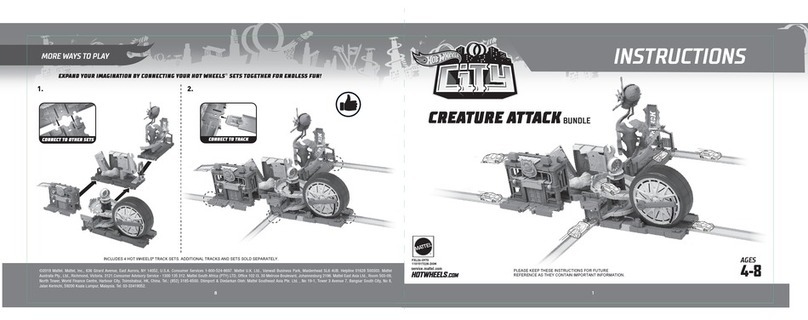
Mattel
Mattel HotWheels City CREATURE ATTACK BUNDLE instructions

Mega Bloks
Mega Bloks HALO 97084 manual
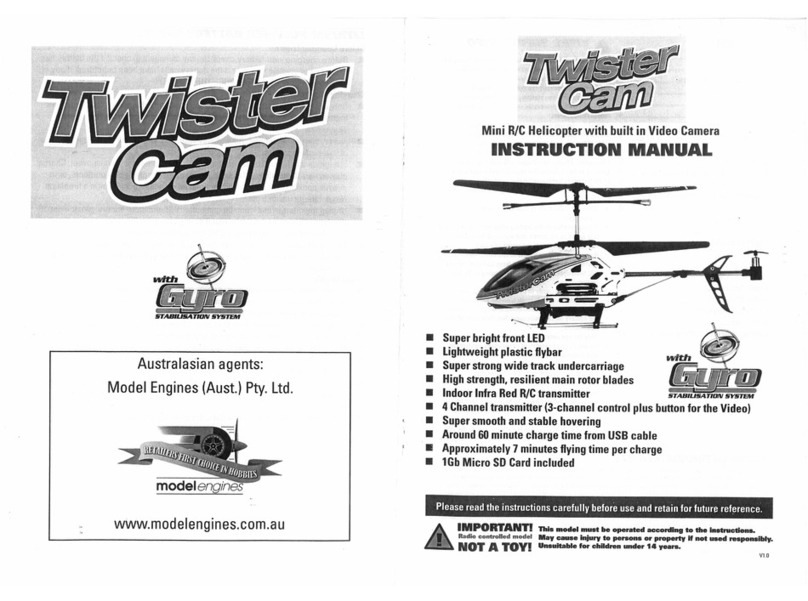
Model Engines
Model Engines Twister Cam instruction manual

Fisher-Price
Fisher-Price GGD49 instruction sheet

Little Tikes
Little Tikes CAPE COTTAGE PLAYHOUSE 637902M Assembly instructions
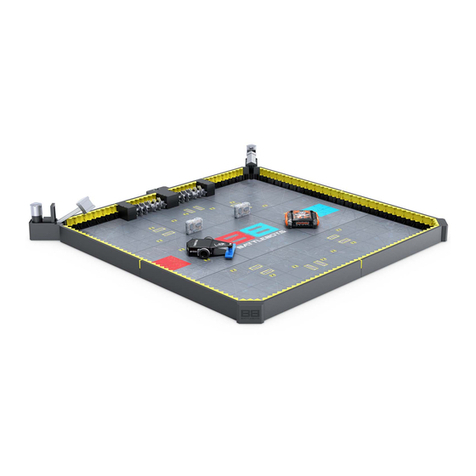
Hexbug
Hexbug BattleBots Arena MAX manual
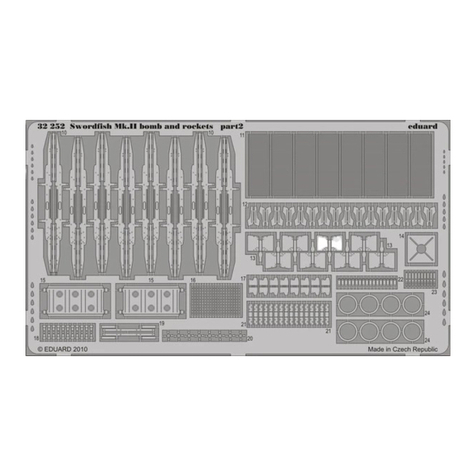
Eduard
Eduard Swordfish Mk.II bomb and rockets Assembly instructions
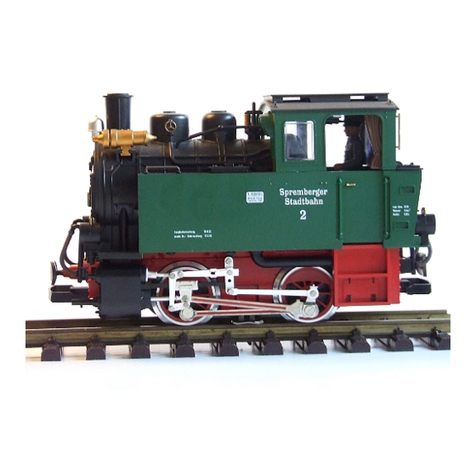
LGB
LGB 21761 instruction manual
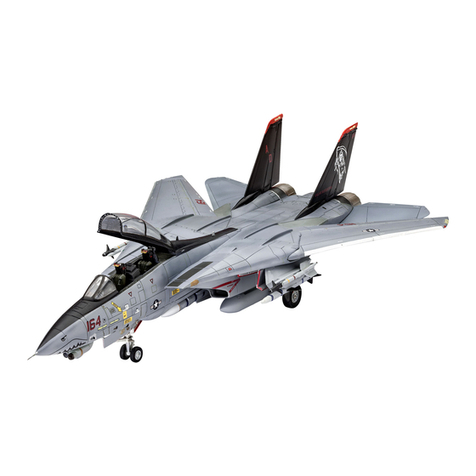
REVELL
REVELL F-14D Super Tomcat Assembly manual



